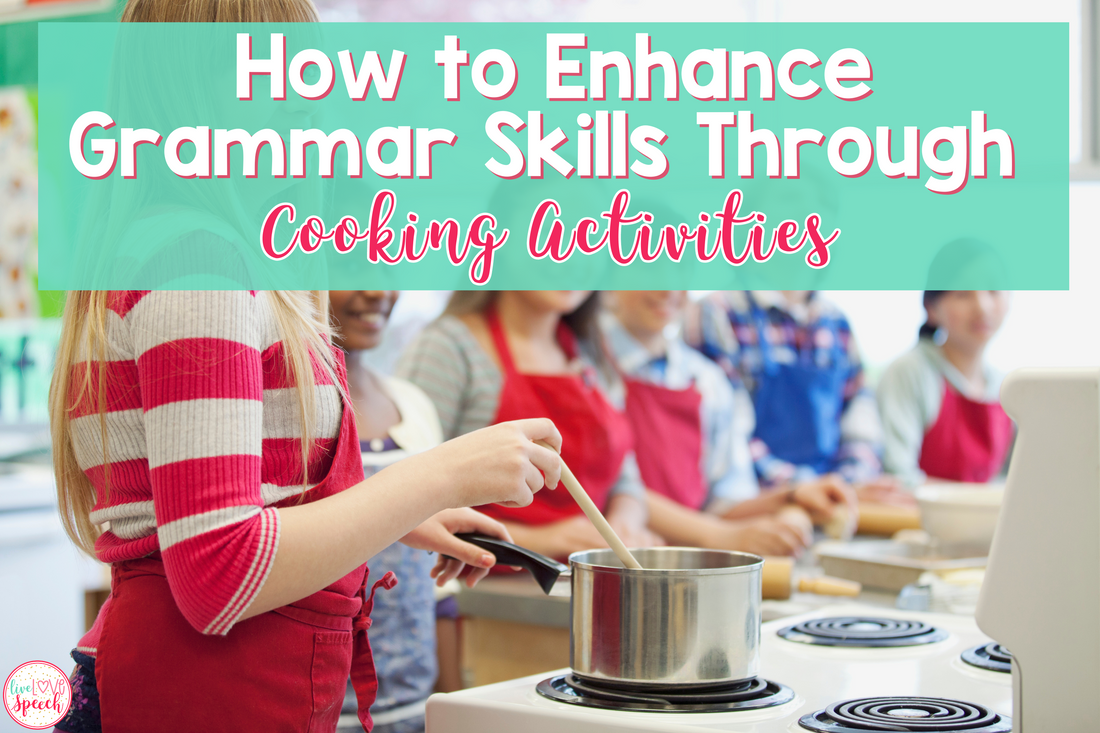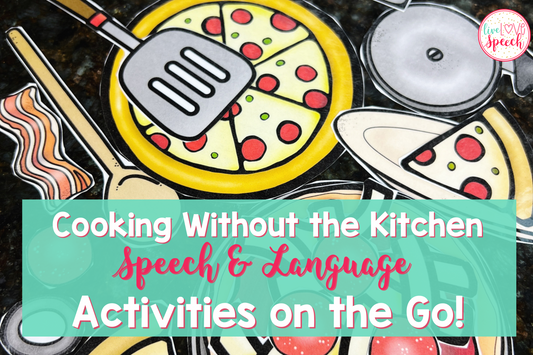
Teaching grammar can often come with endless worksheets and not-so-fun activities. As educators, we strive to make every aspect of learning as engaging and understandable as possible for our kiddos. We want them to thrive in every way possible. But what if I told you that grammar didn’t need to be addressed through endless worksheets or boring activities? It could actually be done right in the kitchen OR classroom while cooking with your students and/or clients.
Cooking isn’t just about making delicious food; it’s a form of teaching in itself—a blend of art, science, and, surprisingly, grammar. Over the years, I have found that cooking is a great way to teach and have fun at the same time. Today, I want to explore strategies for targeting grammar during cooking activities, which will help both parents and SLPs integrate language development into cooking experiences.
 Why Use Cooking to Target Grammar?
Why Use Cooking to Target Grammar?
Cooking activities provide a rich context for practicing grammar skills. The kitchen becomes a classroom (or you can literally cook in your classroom) where children can naturally encounter and use various grammatical structures. Whether it’s following a recipe, discussing ingredients, or describing the steps involved, cooking offers endless opportunities for meaningful language practice. This hands-on learning experience not only makes learning grammar enjoyable but also helps children see the practical application of language skills in everyday life.
-
Meaningful Context: Cooking offers real-life scenarios where grammar concepts can be applied naturally. For example, you can use cooking to practice sequencing by asking your students to describe the steps involved in a recipe using proper order words like "first," "next," and "finally."
-
Hands-On Engagement: The tactile nature of cooking promotes active participation and enhances learning. When children measure ingredients, they can practice using comparative and superlative adjectives (e.g., "more," "less," "most," "least") to describe quantities.
-
Multi-Sensory Experience: Engaging multiple senses during cooking can strengthen memory and retention of grammar rules. The sensory experiences of tasting, smelling, and feeling different ingredients can help reinforce descriptive language and expand vocabulary.
Practical Tips for Targeting Grammar
Here are effective ways to incorporate grammar practice into cooking sessions:
-
Model Correct Grammar: Demonstrate and model grammatically correct sentences while cooking. Use complete sentences to describe cooking actions and instructions (e.g., "I am stirring the batter," "We need to chop the vegetables"). By consistently using correct grammar, you provide a strong example for children to imitate, reinforcing proper language usage in a practical context.
-
Focus on Verb Tenses: Use cooking activities to practice different verb tenses. For instance:
- Present Tense: "I mix the ingredients together."
- Past Tense: "I stirred the soup yesterday."
-
Future Tense: "Tomorrow, we will bake cookies." Discussing actions in different tenses helps children understand the concept of time in language and how verb forms change accordingly.
-
Target Pronouns: Practice pronoun usage during cooking tasks:
- Subject Pronouns: "She is cutting the fruit."
-
Object Pronouns: "He gave me the spoon." Integrating pronouns into cooking conversations can help children grasp the correct use of different pronouns in various contexts, enhancing their overall grammatical accuracy.
-
Expand Sentence Structure: Encourage children to expand their sentences by adding descriptive words and clauses:
- Simple Sentence: "I stir."
-
Expanded Sentence: "I carefully stir the thick batter in the bowl." By elaborating on simple sentences, children learn to add more detail and complexity to their language, improving their expressive abilities.

-
Create Storytelling Opportunities: Prompt children to narrate a cooking story using proper grammar. For example: "Once upon a time, the chef mixed the flour and eggs to make a delicious cake." Storytelling not only engages children's creativity but also reinforces narrative skills and the use of correct grammar in longer discourse.
-
Use Visual Recipes: Visual recipes, which include pictures along with written instructions, can be extremely helpful for children. They provide a clear, step-by-step guide that combines text with images, making it easier for children to understand and follow the recipe. This also helps them associate written instructions with actions, enhancing their reading comprehension and ability to follow sequential instructions. By visually breaking down each step, children can more easily grasp the grammatical structure of instructions, which typically involve imperative verbs and sequential order words, thus reinforcing their understanding and use of these grammatical elements. To find out more about Visual Recipe click here Visual Recipe Cards For Kids – Live Love Speech
-
Play Grammar Games: Incorporate grammar-focused games during cooking:
- Fill-in-the-Blank: "Before ___, we need to ___ the vegetables."
- Sentence Scramble: Arrange jumbled words into grammatically correct sentences related to cooking. These interactive activities make learning grammar fun and dynamic, allowing children to practice language skills in an enjoyable and meaningful way.
Benefits of Cooking for Grammar Development
By integrating grammar practice into cooking activities, children can:
🌟 Gain Practical Experience: Applying grammar rules in real-world contexts helps children understand the relevance and application of language skills beyond the classroom. Cooking provides a natural setting where they can see how proper grammar is essential for clear communication.
🌟 Improve Sentence Structure, Verb Usage, and Pronoun Skills: Through hands-on learning, children can practice constructing sentences, using verbs in different tenses, and applying pronouns correctly. The repetitive nature of cooking tasks reinforces these skills and promotes mastery over time.
🌟 Enhance Communication Abilities and Language Fluency: Engaging in enjoyable cooking tasks encourages children to communicate effectively and fluently. As they describe their actions, follow recipes, and share their experiences, they develop stronger speaking and listening skills.
🌟 Boost Vocabulary and Descriptive Language: Cooking introduces children to a wide range of vocabulary related to ingredients, cooking methods, and sensory experiences. Describing the textures, smells, and tastes of different foods helps expand their descriptive language abilities.
🌟 Promote Collaborative Learning: Cooking often involves working with others, whether it's with parents, siblings, or peers. This collaboration fosters conversational skills, turn-taking, and the use of polite language, further enhancing their social communication skills.
Let's Cook Up Grammar!
Cooking activities offer a great platform for targeting grammar skills and fostering language development. Whether you are a parent or an SLP, these tips can help transform cooking into valuable language-learning opportunities. And that is one thing I strive to do: support others in teaching our kids essential language skills.
language development. Whether you are a parent or an SLP, these tips can help transform cooking into valuable language-learning opportunities. And that is one thing I strive to do: support others in teaching our kids essential language skills.
Two recommendations I have developed to assist with grammar instruction are:
-
Visual Recipe Cards: I offer both physical and monthly themed digital visual recipes. These are great for learning grammar because they provide a clear, step-by-step guide that helps children associate written instructions with actions, reinforcing their understanding of grammatical structures.
- Grab N' Go Grammar Task Cards: These Common Core-aligned task cards provide additional grammar practice. Students can use magnetic chips, bingo daubers, play-doh, or markers to choose the correct answers.

Included are data sheets allow for easy progress monitoring throughout the year for all task cards. Black and white flashcards, along with a parent/guardian letter, which is ideal for homework and carryover. This versatile tool can be used alongside cooking activities to reinforce grammar skills in a fun and engaging way.
How do you use cooking to target grammar skills? Share your favorite strategies and experiences in the comments below! Let's cook up some grammar success together.
SAVE THIS POST
Don't forget to save this post on your favorite Pinterest board so you can come back and check out engaging ways to do Grammar!!!





